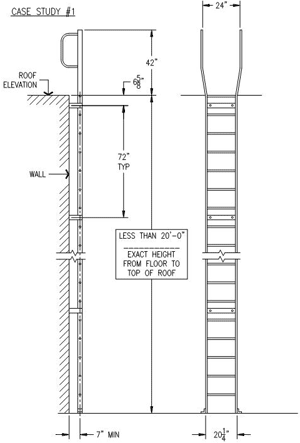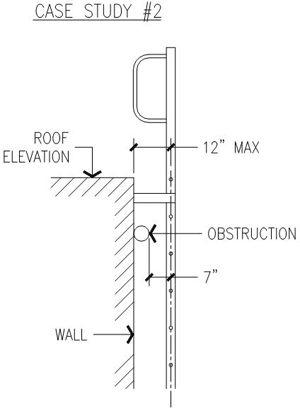Reaching the Roof: Specifying Fixed Access Aluminum Ladders for Safety and Efficiency
Installed in virtually every commercial structure, fixed access aluminum ladders are a necessary feature for maintaining both building equipment and occupant safety.
![]() Continuing Education
Continuing Education
Use the following learning objectives to focus your study while reading this month’s Continuing Education article.
Learning Objectives - After reading this article, you will be able to:
- Summarize code standards for fixed access ladders that ensure the health, safety, and welfare of users.
- Discuss the safety and code compliance aspects of different types of fixed access ladders.
- Identify uses and applications of fixed access ladders.
- Evaluate design features and materials required for safe fabrication and installation.
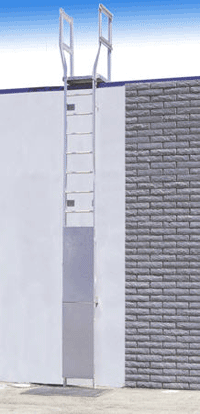 Configuration shown: platform over parapet
Configuration shown: platform over parapet
Ladders have always occupied an iconic role in art and allegory. They are a metaphor for moving upwards, whether to heaven or a cliff-face dwelling. Cave artists translated the metaphor literally when they painted unmistakable images of ladders, as did stone masons who carved angels gracing ladders on medieval cathedrals.
Today, we prefer to think of them as tools for reaching roofs and upper stories, broadly categorized as portable ladders or fixed access ladders. A portable ladder, as the name implies, refers to those ladders, which can be carried. A fixed access ladder is a ladder which is permanently attached to a structure either at one or both ends.
Fixed access ladders are found in virtually every commercial building, most often required by building codes as a means of reaching equipment located on the roof. Yet a fixed access ladder, being relatively small and often an afterthought to the design and construction of an entire building, is sometimes ignored and its design left to the last moment or hurriedly specified in response to urging from the building inspector. Unfortunately, uninformed specification, inadequate communication with fixed ladder manufacturers and lack of knowledge regarding code compliance can and often does lead to faulty ladder installations with potentially dangerous results. A knowledge of ladder materials and construction, code compliance and safety issues, plus the ability to evaluate site requirements and interpret manufacturers specifications are therefore all critical.
Ladder Materials and Construction
Materials
Traditionally constructed from wood, ladders were heavy and time consuming to fabricate on site. The introduction of aluminum and mass produced steel in the 19th century not only transformed the way ladders could be constructed, but radically opened up manufacturing possibilities for fixed ladders. While an improvement over wood, steel has similar disadvantages. However aesthetically desirable for an urban loft ladder, it is, like wood, heavy, costly to ship, requires considerable manpower and equipment to install and is subject to rust and corrosion.
Aluminum, on the other hand, is lightweight, flexible, can be engineered to precise conditions off site, is not subject to rust and corrosion and is the ideal material for the construction of fixed access ladders and their numerous industrial and commercial applications. Structural aluminum is supplied in various grades, which affect the strength, sturdiness, thickness and width of ladder components. Ladder manufacturers most commonly select grades 6063-T5 and 6061-T6.
Aluminum alloy 6063 grades are mostly used in extruded shapes for architecture, particularly window frames, door frames, and roofs. Aluminum alloy 6061 is used in aircraft structures, yachts, and automotive parts, depending on the temper, or heat treatment, of the material. In functional terms, aluminum alloy 6061-T6 is 119 percent stronger than the more commonly used 6063-T5 extrusions and therefore offers enhanced safety and longer life. It is also 58 percent harder which provides more resistance to scratches and abrasions.
Other materials: steel, stainless steel, and fiberglass, to name a few that are available. Each has specific features that may be required for any particular installation.
Ladder brackets. Critical features of a fixed access ladder are the ladder brackets that anchor the ladder to the structure. As with the composition of ladder material, the aluminum grade of the brackets is crucial, as are the number of brackets and their size, for ensuring a safe, secure and ergonomic ladder system. The use of high strength aluminum alloy 6061-T6 provides stiffer brackets which means less deflection when the ladder is being used. Installing two 3/8-inch bolts rather than a single 3/16-inch bolt on each side to attach the bracket to the ladder further enhances security.
When specifying ladders, architects should note the grade of aluminum to be used in manufacturers' specs. This, and other details of materials, should be determined by the specific requirements of the installation and the need for long term durability. Different aluminum alloys are compatible with each other, but strengths do vary. For example, 6061-T6 is a heat-treated alloy that has the equivalent strength of mild structural steel. A properly designed ladder system will have the structural members all supporting their share of the load while not exceeding the material strength of the alloy.
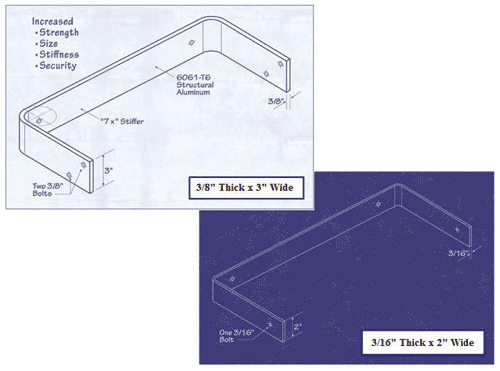
Larger-sized ladder brackets add strength, stiffness and security to ladder installation
Ergonomics
Ideally, the design and construction of fixed access aluminum ladders should reflect the ergonomics of climbing ladder steps.
Vertical ladders. For vertical ladders fixed at 90 degrees, round rungs provide a stronger, more comfortable grip when pulling up. Round rungs also provide a more natural support for the feet, which pivot while climbing straight up. Ideally, rungs should have a serrated surface for a no-slip grip and be secured to the side rails with cast aluminum connectors, using four solid aircraft rivets on each rung. This gives a permanent, no-twist installation that has a combined shear strength of over 3,600 pounds for each rung. For anchoring strength, fixed ladders should come with mounting brackets that are 3/8-inch thick aluminum bar, pre-punched to provide 16-in. on center mounting holes. Brackets should be provided for every six feet in length of the fixed ladder.
Angled ladders. For angled ladders, flat steps give the best support when climbing at an angle. Ships and folding ladders should be available with steps of varying depths. To best suit climbers' feet, ladders with a greater angle from the floor—60 degrees for example—should have a greater depth. Steps should also be permanently affixed to the side rails using eight solid rivets per step, with non-slip ridges on the top. Flush or extended handrails need to be designed to fit the users' hands, giving a comfortable grip when steadying the body during climbing.
Standards and Safety
The American National Standards Institute (ANSI) and the Occupational Safety and Health Administration(OSHA) issue national standards regarding fixed ladders. Both sets of standards are virtually the same as each organization takes turns to institute changes.
Titled ANSI A14.3-2008 American National Standard for Ladders - Fixed - Safety Requirements is available from webstore.ansi.org. ANSI standards detail specifications on the various materials, construction requirements, test requirements, usage guidelines and labeling/marking requirements for fixed access ladders (CHECK).
OSHA Regulations (Standards - 29 CFR) Fixed ladders. - 1910.27 are available for download at www.osha.gov. OSHA also publishes a Booklet Guide to the 1910.27 regulations titled Stairways and Ladders, A Guide to OSHA Rules, OSHA 3124-12R 2003 (www.osha.gov/Publications/OSHA3124/osha3124.html).
The latter is a general overview of the OSHA standards and covers the rules for all ladders included fixed ladders (see sidebar).
The following code requirements are the most important for architects, specifiers and project managers to be familiar with (for fuller code wording see sidebar):
Requirement for Fixed Ladder
A double-cleated ladder or two or more ladders must be provided when ladders are the only way to enter or exit a work area having 25 or more employees, or when a ladder serves simultaneous two-way traffic.
Live Load
*A fixed ladder must be able to support at least two loads of 250 pounds each, between any two support brackets.
Landing Platforms
Required when ladders are used to ascend to heights exceeding 30 feet. Or required for every 20 feet if no cage, well or ladder safety device is provided.
Cages
Cages or safety devices are required for fixed ladders with a length of more than 20 feet to a maximum unbroken length of 30 feet. A safety device is generally more expensive to install than a cage. The bottom of the cage must be between 7 feet and 8 feet above the point of access to the bottom of the ladder. The top of the cage must be a minimum of 42 inches above the top of the platform or the point of access at the top of the ladder. As of November 2019, OSHA requires ladders over 24 feet to have a fall proection device. (See sidebar for more information.)
Designing Fixed Access Ladders
A first and obvious step to specifying a fixed access aluminum ladder is to know the particular function and location of the ladder since the location dictates the type of ladder required:
- How much space is there for accessing the ladder? What is the daily traffic pattern of the area at the base of the ladder? This will help determine the type of ladder required:, a ships ladder at 60 degrees takes up far more area than a folding ladder at 80 degrees or a vertical fixed ladder .
- How often is the ladder going to be used? A ships ladder at 60 degrees is easier to climb than a fixed vertical ladder and is therefore safer. If an employee rest area is located on a mezzanine floor, as is often the case in fabricating facilities, the ladder will have heavy use. A ladder accessing roof equipment would have regular but far less use.
- Are people who are using the ladder going to be carrying heavy or awkward loads? Is the ladder accessing a mezzanine where inventory is stored? Often concrete tilt-up buildings are one story tall and use fixed access ladders to reach storage spaces.
- Who will be using the ladder?
In a somewhat misguided concern for safety, one designer specified a fixed ladder should support loads of 1000 pounds In this particular case the ladder was not reaching a storage area, and employees, firemen, inspectors and service contractors, were expected to use it on an irregular basis. Not only would the ladder have been excessively expensive as a result of custom fabricated components, but unnecessary given that probably no person weighing 1000 pounds would be climbing it. The loading specified by OSHA and ANSI has been developed from years of study based on usage. However, when exceptional conditions warrant, ladders can be designed for additional loading. - What is the purpose of the ladder? Exterior roof access, roof hatch access or mezzanine access?
The manufacturer should be able to guide you through the design process, and provide easily downloadable specifications.
Exterior Roof Access
Fixed vertical wall ladders provide permanent exterior roof access. They are ideal for chimneys, towers, vats, antennas, tanks, water treatment plants, refineries and other industrial or marine applications. Remember that ladders in excess of 20 feet require cages and rest platforms are required for each 30 feet of height. Side exits and ladder step through are other means of access and egress. Typical specifications include side rails with 11/8-inch round rungs that are serrated and secured with cast aluminum connectors, 4 solid rivets and 3/8-inch thick brackets mounted to the walls.
Several different vertical ladder configurations include: Handrails over the roof, side exit, roof return and parapet return.
Roof Access with Security Doors
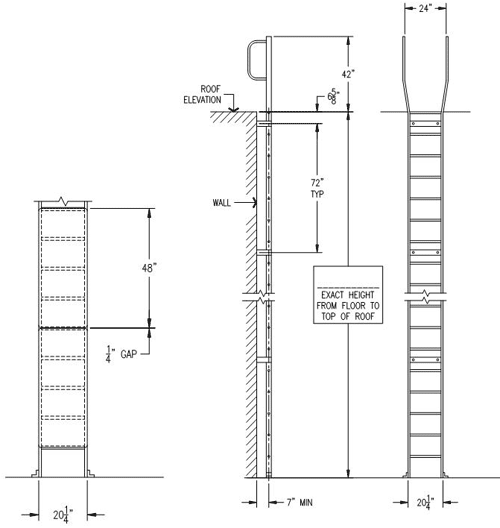
Configuration shown: roof access
Right: Exterior roof access vertical fixed ladder with handrails extending 42 inches over the roof. Left: Configuration showing placement of the security door.
Caged with Platforms
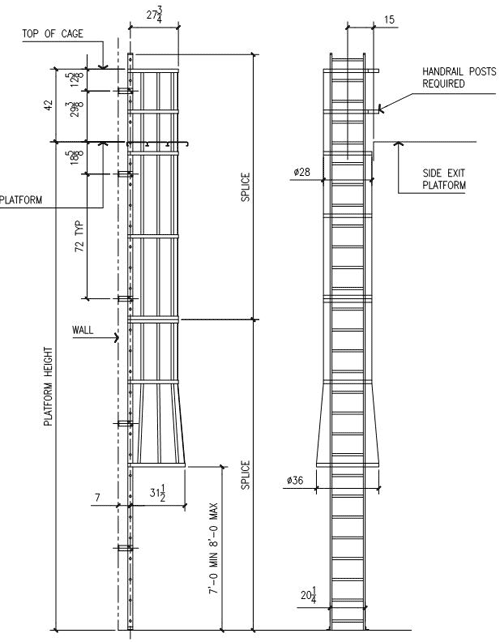
Configuration shown: caged side exit platform access
Exterior roof access ladder with side exit. A cage is required because the ladder is in excess of 20 feet. Note the bottom of the cage must be between 7 feet and 8 feet above the point of access to the bottom of the ladder. Also note the flaring dimensions of the enclosure at the lower end of the cage. This is a code requirement to aid the ladder user in climbing the ladder.
Roof Return
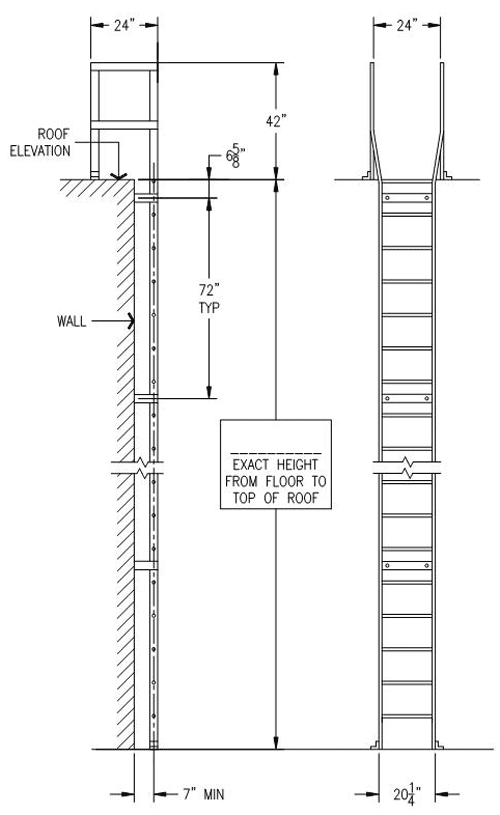
Configuration shown: roof access roof return
Exterior roof access fixed ladder with roof return. The roof return is the portion of the ladder mounted above the roof and means that the ladder is returning to the roof.
Platform over Parapet
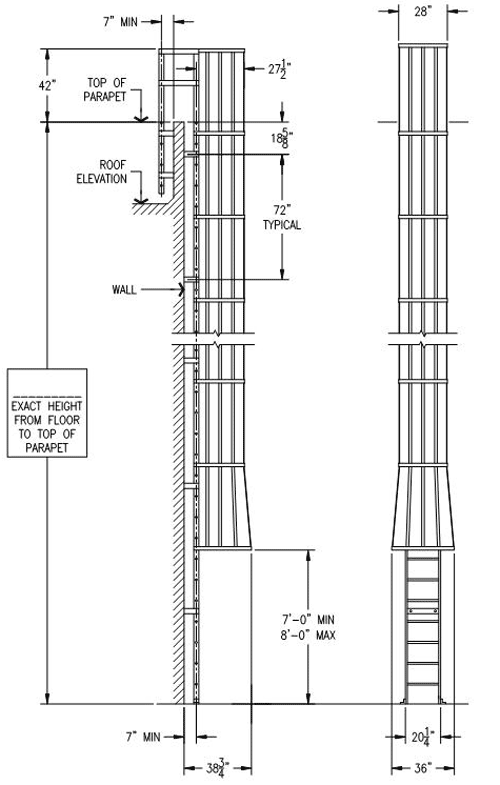
Configuration shown: caged roof access over parapet
Exterior roof access showing parapet return and cage. The parapet return is the portion of the ladder that returns from the parapet to the roof level. The return would be required anytime the distance from the parapet to the roof is greater than about 12 inches (305 millimeters).
Roof Hatch Access
Governed by OSHA Regulations 1910.23 & 1910.27, roof top hatches should provide safe egress and ingress through the roof. Hinged and guarded by railings with a standard height of 12 inches, they are in effect a ladderway floor opening, the roof being the floor or platform.
Fixed access options for roof hatch access include ships ladders permanently angled at different degrees, folding ladders, vertical fixed wall ladders and retractable ladders.
Ships ladders are designed for access to roof hatches, mezzanines, equipment lofts and other restricted spaces. They usually include heavy duty aluminum top and bottom brackets for a fixed, permanent installation. Typically, they are available in 60 degrees 70 degrees and 80 degrees with maximum heights varying between 15 feet and 20 feet. They can be specified with or without side rails and with or without extended side rails.
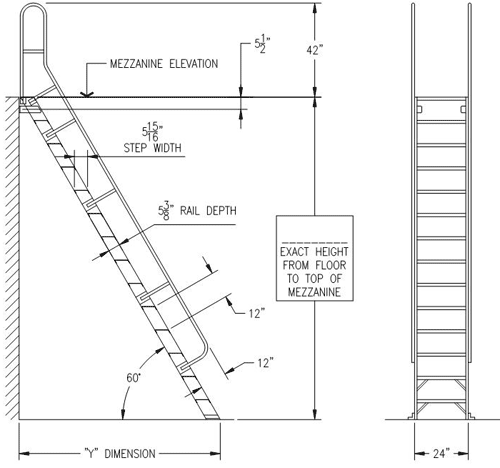
Configuration shown: ships ladder with handrails mezzanine access
Ships ladder fixed at 60 degrees with extended handrails for easy climbing, this model has a maximum height of 15 feet.
Pivotal ladders are suitable for limited space and can be folded away when not in use. Typically they are available with no-marking, solid rubber feet for secure floor contact when not in use and have optional flush handrails.
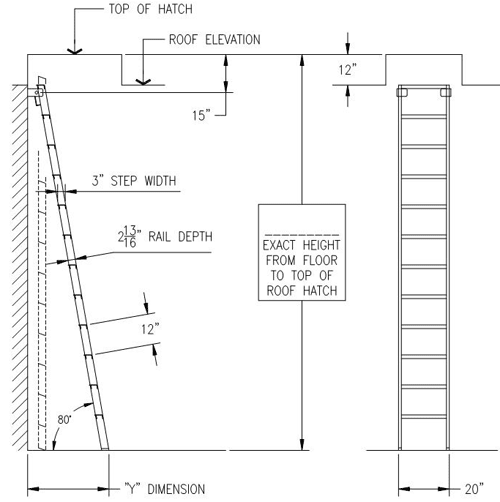
Configuration shown: ships ladder without handrails roof hatch access
Pivotal ladder hinged at the top extends 80 degrees from the horizontal.
Retractable ladders are designed for space saving interior access to roof hatches from small rooms. They are ideal for restaurants, tool storage rooms, workshops and mini warehouses.
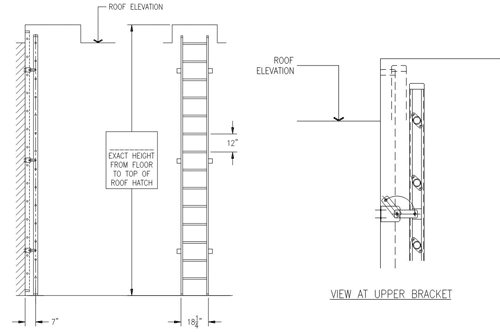
Configuration shown: retractable vertical ladder roof hatch access
Right: Retractable ladder saves space when accessing roof hatches from the interior of small rooms. Left: Upper bracket detail for retractable ladder. Rotating brackets allow the ladder to be extended.
Mezzanines
Ships ladders and pivotal ladders with required side rails are generally specified for mezzanine access.
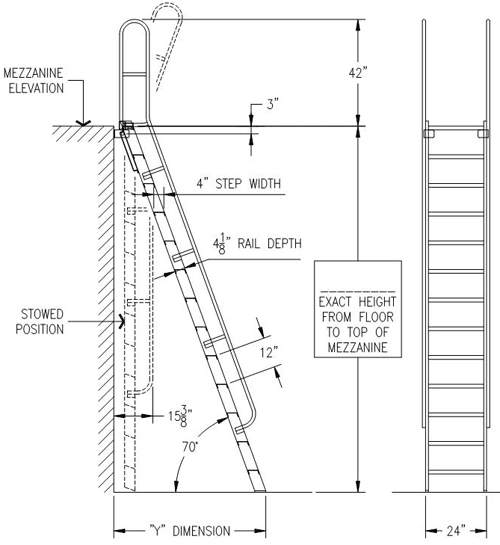
Configuration shown: pivotal ships ladder mezzanine access
A 70-degree pivotal ladder with hinged bracket for mezzanine access requires an extended handrail.
Case Studies
While the majority of fixed access aluminum ladders are specified and installed correctly according to code, manufacturers tell many stories of things not going quite right. On one occasion the contractor on the job site removed and reconfigured the ladder brackets to make the ladder fit, thereby making the ladder unsafe. Fortunately, the manufacturer discovered the change before the building was occupied. Other examples reveal the challenges of designing according to code:
Conclusion
Fixed access ladders are necessary tools for the efficient functioning of virtually all commercial buildings and the health, safety and welfare of their occupants. As with all tools, they need to be evaluated in terms of the code standards that govern their use and the how and where they are employed. In centuries past, an image sufficed for understanding the role and purpose of ladders. Today, all ladders, especially fixed access ladders, demand much, much more.

|
ALACO is a manufacturer of special purpose and custom designed ladders to fit a variety of residential, commercial and industrial applications. Established in 1946, ALACO now manufactures over 800 different models of aluminum, wood and fiberglass ladders, including a complete line of commercial and designer rolling ladders. www.alacoladder.com |

